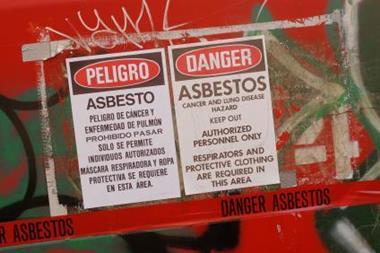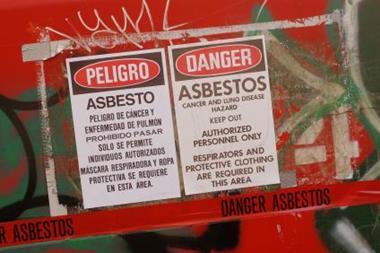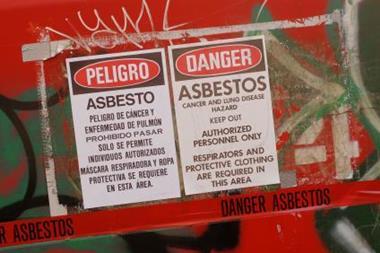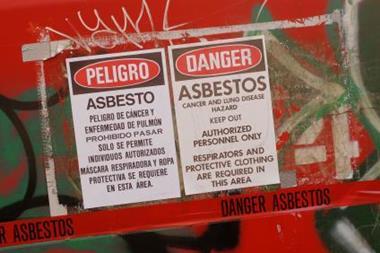About 27 million Americans were exposed to asbestos last century – as were many UK workers. The damage caused by the ‘wonder’ industrial material resulted in a flood of court cases in both countries. But as claims rise in the UK, across the pond the deluge may be easing
Asbestos claims have haunted insurance companies here and in the USA for decades. They also contributed to the problems experienced by Lloyd’s in the early 1990s, which resulted in the formation of Equitas.
Recent developments, however, suggest that the situation may be stabilising, in the States at least. In 2008 the US insurance industry increased its net ultimate claims by $1.1bn (£681m), the smallest annual increase for at least a decade – a decade in which the US industry increased those ultimates by more than $30bn. It is important to note, though, that there have been many false dawns in the asbestos saga and there are significant numbers of claims still to be paid.
Insurers here are also exposed (asbestos was heavily used last century in industries such as shipbuilding), with a number of legal developments affecting mesothelioma and pleural plaques claims.
There is still much uncertainty about the future number and cost of UK asbestos claims, and the insurance industry’s exposure to them. The Actuarial Profession’s UK asbestos working party recently updated its estimate of the future cost of asbestos claims from £4.7bn for 2009 to 2040, to £11bn for 2009 to 2050. The working party’s research has shown that the proportion of mesothelioma sufferers that make a claim has doubled from about one-third in 2004 to nearly two-thirds. This unexpected change explains most of the increase in the working party’s estimates and, it says, should not surprise insurers, which will have already noticed the increased number.
A difficult history
Asbestos is a naturally occurring silicate with many attractive properties: it is resistant to heat, fire and corrosion, and is relatively inexpensive. For decades it was used in virtually every industrial process involving heat and/or friction.
But it is now known to cause a number of diseases; mesothelioma – cancer of the lining of the lung – is the most severe. Mesothelioma tends to have a long latency that can, in some cases, stretch to 50 or 60 years. It is usually fatal within two years of diagnosis.
Last century, about 27 million Americans had significant occupational exposure to asbestos.
In the early days, people suffering from asbestos-related diseases sued their employers who, in turn, made a claim under their workers’ compensation insurance policies. However, the sizes of awards were fairly limited. In the early 1970s a landmark case transferred the liability to the manufacturers of the asbestos-containing products. In turn, the manufacturers made a claim under their product’s liability insurance policies.
The volume and amount of the claims has forced many of the largest manufacturers of asbestos-related products into bankruptcy. Claims were then made against the (often smaller) peripheral defendants, who manufactured products containing only traces of asbestos, and against those companies that did not manufacture products containing asbestos, but owned or operated a facility where they were used.
To achieve large settlements, plaintiff lawyers typically bundled a large number of non-malignant claims with a handful of more serious malignant claims. Strategically positioned scan vans were also used to find more and more potential claimants. Claims were also filed in “plaintiff friendly” jurisdictions with which the claimant often had no obvious connection. For example, at the height of the litigation, nearly one in five of all asbestos claims were filed in Mississippi, home to about 1% of Americans.
Positive developments
In response to a spiralling crisis and in the absence of any federal legislation to curb the problem, about one-third of US states have now enacted a combination of tort reforms to combat the tide of asbestos claims. For example, some have introduced legislation preventing claimants from receiving compensation unless they meet certain medical criteria. Other moves include reforms intended to stop “forum shopping” and the introduction of “inactive dockets”.
These tort reforms appear to be having some success. The number of claims filed against the Manville Trust (an often cited barometer of the level of US asbestos litigation) has fallen from a peak of more than 100,000 in 2003 to just over 10,000. Plus, the proportion of claims filed for non-malignant conditions has fallen from more than 90% to just over half.
Good news for insurers?
Analysts predict that the total economic cost of US asbestos will be between $200bn and $275bn, with between $55bn and $80bn of that expected to fall on the US insurance industry. Based on the annual statutory filings, the US insurance industry has booked about $64bn (net of reinsurance) in respect of its US asbestos liabilities as at 31 December 2008. Industry estimates therefore imply anything between a surplus of $9bn and a deficit of $16bn, although a surplus would seem unlikely. In fact, one market commentator recently increased its estimate of the ultimate cost of asbestos claims to the US insurance industry.
A significant proportion of the asbestos liabilities insured by the US insurance industry are reinsured outside the States, primarily in the London market. Using the US industry statutory filings data and by allocating insurers between primary and reinsurance companies based on their assumed core business, Deloitte has estimated that the US insurance industry took about $12bn of reinsurance credit for US asbestos claims from non-US reinsurers as at 31 December 2008. This is in addition to the substantial US asbestos exposures that were written directly outside the US, again predominantly in the London market.
It is therefore likely that a fair proportion of the positive developments experienced by US insurers should flow through to insurers outside its borders.
What does the future hold?
This may be a welcome respite for insurers across the globe, but it is important to bear in mind that significant amounts are still expected to be paid in the future; the US insurance industry’s net asbestos reserves as at year-end 2008 were more than $20bn alone.
Consequently, it is vital that insurers keep a close eye on their US asbestos liabilities and have a thorough understanding of their underlying exposures. In addition, with Solvency II very much on the horizon, European insurers will need to have a good handle on the variability surrounding any estimates of their asbestos liabilities.
To help insurance companies to estimate and monitor their liabilities arising from particular asbestos defendants, actuaries have developed sophisticated exposure-based modelling techniques. These take into account the specific circumstances affecting each defendant/insurer combination to produce appropriate estimates. IT
Darren Michaels is a director in Deloitte’s actuarial and insurance solutions team.
Hosted by comedian and actor Tom Allen, 34 Gold, 23 Silver and 22 Bronze awards were handed out across an amazing 34 categories recognising brilliance and innovation right across the breadth of UK general insurance.














































No comments yet